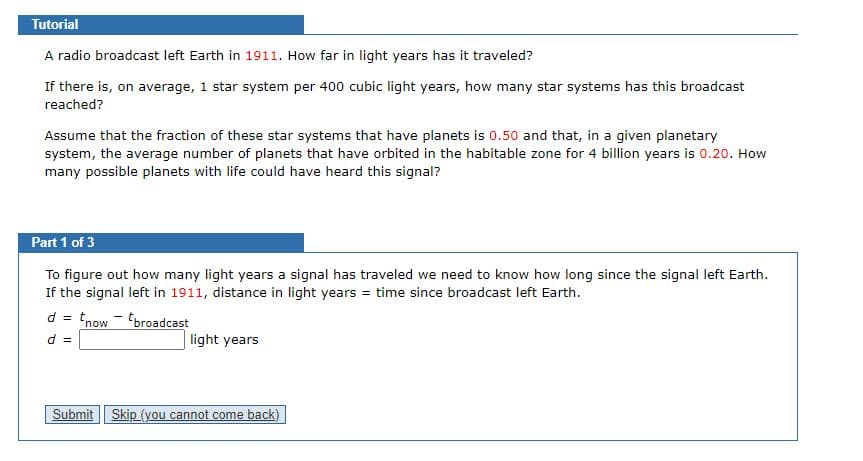A radio broadcast left Earth in 1911. How far in light years has it traveled? If there is, on average, 1 star system per 400 cubic light years, how many star systems has this broadcast reached? Assume that the fraction of these star systems that have planets is 0.50 and that, in a given planetary system, the average number of planets that have orbited in the habitable zone for 4 billion years is 0.20. How many possible planets with life could have heard this signal?
A radio broadcast left Earth in 1911. How far in light years has it traveled? If there is, on average, 1 star system per 400 cubic light years, how many star systems has this broadcast reached? Assume that the fraction of these star systems that have planets is 0.50 and that, in a given planetary system, the average number of planets that have orbited in the habitable zone for 4 billion years is 0.20. How many possible planets with life could have heard this signal?
Astronomy
1st Edition
ISBN:9781938168284
Author:Andrew Fraknoi; David Morrison; Sidney C. Wolff
Publisher:Andrew Fraknoi; David Morrison; Sidney C. Wolff
Chapter30: Life In The Universe
Section: Chapter Questions
Problem 23E: In this chapter, we identify these characteristic properties of life: life extracts energy from its...
Related questions
Question
A radio broadcast left Earth in 1911. How far in light years has it traveled?
If there is, on average, 1 star system per 400 cubic light years, how many star systems has this broadcast reached?
Assume that the fraction of these star systems that have planets is 0.50 and that, in a given planetary system, the average number of planets that have orbited in the habitable zone for 4 billion years is 0.20. How many possible planets with life could have heard this signal?

Transcribed Image Text:Tutorial
A radio broadcast left Earth in 1911. How far in light years has it traveled?
If there is, on average, 1 star system per 400 cubic light years, how many star systems has this broadcast
reached?
Assume that the fraction of these star systems that have planets is 0.50 and that, in a given planetary
system, the average number of planets that have orbited in the habitable zone for 4 billion years is 0.20. How
many possible planets with life could have heard this signal?
Part 1 of 3
To figure out how many light years a signal has traveled we need to know how long since the signal left Earth.
If the signal left in 1911, distance in light years = time since broadcast left Earth.
d =
tnow - tbroadcast
light years
= P
Submit
Skip (you cannot come back)
Expert Solution
This question has been solved!
Explore an expertly crafted, step-by-step solution for a thorough understanding of key concepts.
This is a popular solution!
Trending now
This is a popular solution!
Step by step
Solved in 4 steps with 4 images

Knowledge Booster
Learn more about
Need a deep-dive on the concept behind this application? Look no further. Learn more about this topic, physics and related others by exploring similar questions and additional content below.Recommended textbooks for you

Astronomy
Physics
ISBN:
9781938168284
Author:
Andrew Fraknoi; David Morrison; Sidney C. Wolff
Publisher:
OpenStax


Foundations of Astronomy (MindTap Course List)
Physics
ISBN:
9781337399920
Author:
Michael A. Seeds, Dana Backman
Publisher:
Cengage Learning

Astronomy
Physics
ISBN:
9781938168284
Author:
Andrew Fraknoi; David Morrison; Sidney C. Wolff
Publisher:
OpenStax


Foundations of Astronomy (MindTap Course List)
Physics
ISBN:
9781337399920
Author:
Michael A. Seeds, Dana Backman
Publisher:
Cengage Learning

Stars and Galaxies (MindTap Course List)
Physics
ISBN:
9781337399944
Author:
Michael A. Seeds
Publisher:
Cengage Learning


An Introduction to Physical Science
Physics
ISBN:
9781305079137
Author:
James Shipman, Jerry D. Wilson, Charles A. Higgins, Omar Torres
Publisher:
Cengage Learning